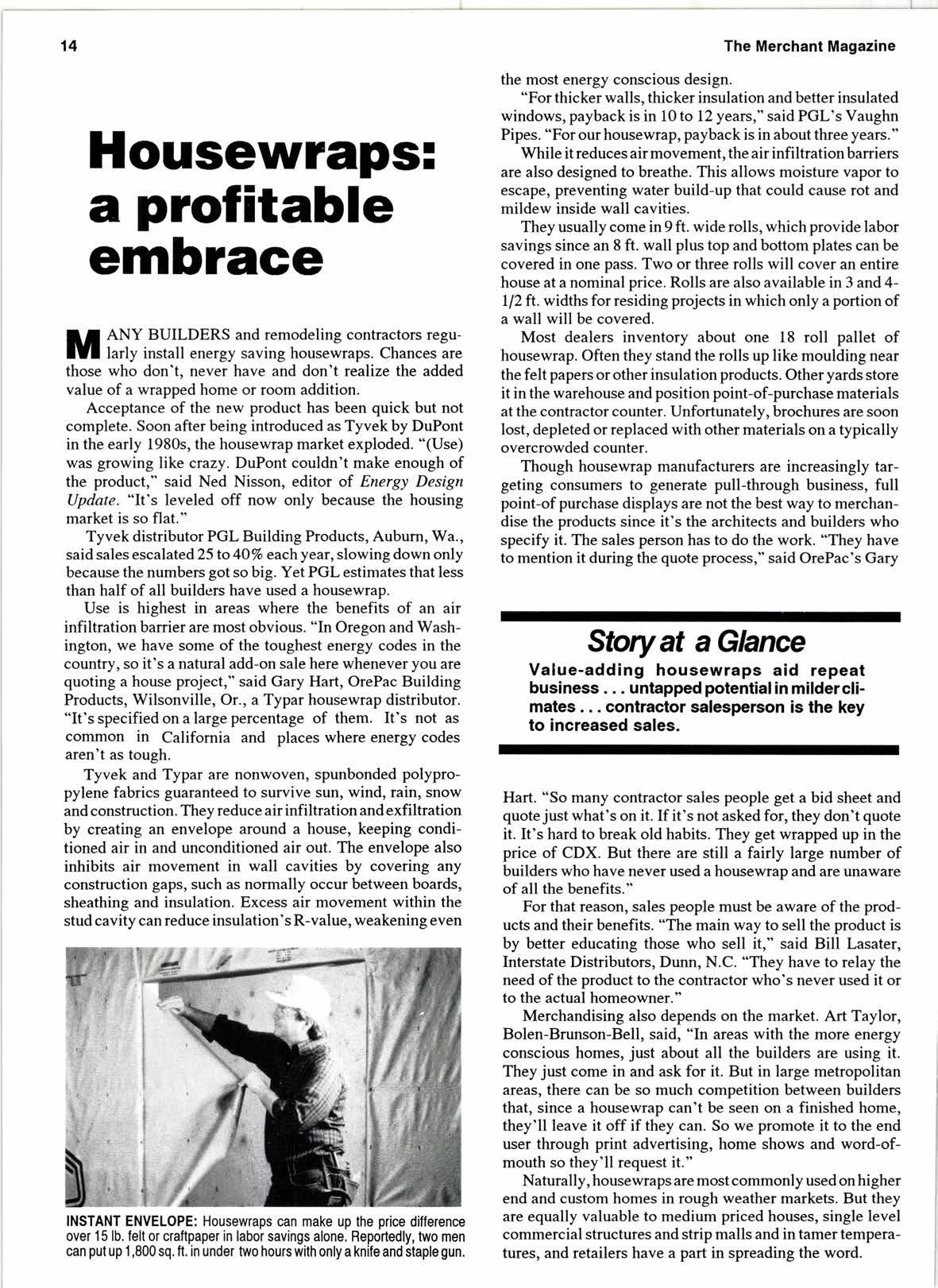
3 minute read
Housewraps: a profitable embrace
ANY BUILDERS and remodeling contractors regulady irstall energy saving housewraps. Chances are those who don't, never have and don't realize the added value of a wrapped home or room addition.
Acceptance of the new product has been quick but not complete. Soon after being introduced as Tyvek by DuPont in the early 1980s, the housewrap market exploded. "(Use) was growing like crazy. DuPont couldn't make enough of the product," said Ned Nisson, editor of Energy Design Update. "It's leveled off now only because the housing market is so flat."
Tyvek distributor PGL Building Products, Auburn, Wa., said sales escalated25 to 4OVo each year, slowing down only because the numbers got so big. Yet PGL estimates that less than half of all builders have used a housewrap.
Use is highest in areas where the benefits of an air infiltration barrier are most obvious. "In Oregon and Washington, we have some of the toughest energy codes in the country, so it's a natural add-on sale here whenever you are quoting a house project," said Gary Hart, OrePac Building Products, Wilsonville, Or., a Typar housewrap distributor. "It's specified on a large percentage of them. It's not as common in California and places where energy codes aren't as tough.
Tyvek and Typar are nonwoven, spunbonded polypropylene fabrics guaranteed to survive sun, wind, rain, snow and construction. They reduce air infiltration and exfiltration by creating an envelope around a house, keeping conditioned air in and unconditioned air out. The envelope also inhibits air movement in wall cavities by covering any construction gaps, such as normally occur between boards, sheathing and insulation. Excess ait movement within the stud cavity can reduce insulation's R-value, weakening even the most energy conscious design.
"For thicker walls, thicker insulation and better insulated windows, payback is in I0 to 12 y ears," said PGL's Vaughn Pipes. "For our housewrap, payback is in about three years."
While it reduces airmovement, the air infiltration barriers are also designed to breathe. This allows moisture vapor to escape, preventing water build-up that could cause rot and mildew inside wall cavities.
They usually come in 9 ft. wide rolls, which provide labor savings since an 8 ft. wall plus top and bottom plates can be covered in one pass. Two or three rolls will cover an entire house at a nominal price. Rolls are also available in 3 and 41/2 ft. widths for residing projects in which only a portion of a wall will be covered.
Most dealers inventory about one 18 roll pallet of housewrap. Often they stand the rolls up like moulding near the felt papers or other insulation products. Other yards store it in the warehouse and position point-of-purchase materials at the contractor counter. Unfortunately, brochures are soon lost, depleted or replaced with other materials on a typically overcrowded counter.
Though housewrap manufacturers are increasingly targeting consumers to generate pull-through business, full point-of purchase displays are not the best way to merchandise the products since it's the architects and builders who specify it. The sales person has to do the work. "They have to mention it during the quote process," said OrePac's Gary
Story at a Glance
Value-adding housewraps aid repeat business untapped potentialin milderclimates... contractor salesperson is the key to increased sales.
Hart. "So many contractor sales people get a bid sheet and quote just what's on it. If it's not asked for, they don't quote it. It's hard to break old habits. They get wrapped up in the price of CDX. But there are still a fairly large number of builders who have never used a housewrap and are unaware of all the benefits."
For that reason, sales people must be aware of the products and their benefits. "The main way to sell the product is by better educating those who sell it," said Bill Lasater, Interstate Distributors, Dunn, N.C. "They have to relay the need of the product to the contractor who's never used it or to the actual homeowner."
Merchandising also depends on the market. Art Taylor, Bolen-Brunson-Bell, said, "In areas with the more energy conscious homes, just about all the builders are using it. They just come in and ask for it. But in large metropolitan areas, there can be so much competition between builders that, since a housewrap can't be seen on a finished home, they'll leave it off if they can. So we promote it to the end user through print advertising, home shows and word-ofmouth so they'll request it."
Naturally, housewraps are most commonly used on higher end and custom homes in rough weather markets. But they are equally valuable to medium priced houses, single level commercial structures and strip malls and in tamer temperatures, and retailers have a part in spreading the word.









